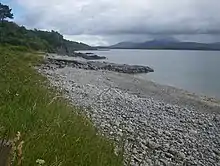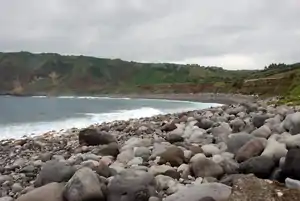Shingle beach
A shingle beach (also referred to as rocky beach or pebble beach) is a beach which is armoured with pebbles or small- to medium-sized cobbles (as opposed to fine sand). Typically, the stone composition may grade from characteristic sizes ranging from 2 to 200 millimetres (0.1 to 7.9 in) diameter.



While this beach landform is most commonly found in Europe, examples are found in Bahrain, North America and in a number of other world regions, such as the west coast of New Zealand's South Island, where they are associated with the shingle fans of braided rivers. Though created at shorelines, post-glacial rebound can raise shingle beaches as high as 200 metres (660 ft) above sea level, at the High Coast in Sweden.
The ecosystems formed by this unique association of rock and sand allow colonization by a variety of rare and endangered species.[1]
Formation
Shingle beaches are typically steep, because the waves easily flow through the coarse, porous surface of the beach, decreasing the effect of backwash erosion and increasing the formation of sediment into a steeply sloping beach.[2]
Tourism
Shingle beaches are incredibly rare and quite beautiful. Made up of thousands of smooth rocks with varying geological qualities and uniqueness. The ocean naturally smoothes the various rocks over time with crashing waves, creating a very original landscape with smooth rounded rocks and interesting designs. Shingle beaches are popular for the varying rock types that can be found.
Examples
- Alby, Sweden
- Birdling's Flat, New Zealand
- Chesil Beach, England
- Dungeness, England
- Humarock, Scituate, Massachusetts
- Egypt Beach, Scituate, MA United States
- Hawar Islands, Bahrain
- Herne Bay, England
- Nice, France
- Osmussaar, Estonia
- Slapton Sands, England
- Short Beach, Oregon, U.S.
- Southsea, England
- The Stade, England
- Sõrve Peninsula, Estonia
- Zrće, Croatia
- Jaz Beach, Montenegro
- Qixingtan - Seven Star Beach, Hualien, Taiwan.
See also
References
- UK's rare shingle beaches at risk, Alex Kirby, BBC News Online, June 3, 2003
- Easterbrook, Don J. Surface Processes and Landforms. 1999 Prentice-Hall Inc. Upper Saddle River, NJ
Further reading
- Chapman, V. J. (2016) Coastal Vegetation chapter 9: Shingle Beaches. Second edition, Elsevier. ISBN 9781483279589


